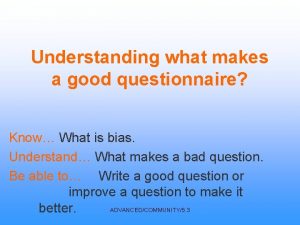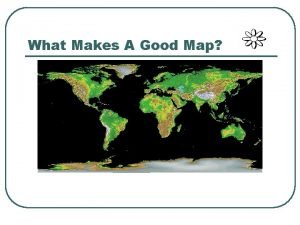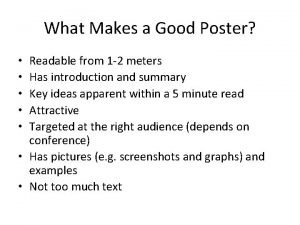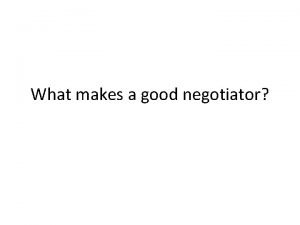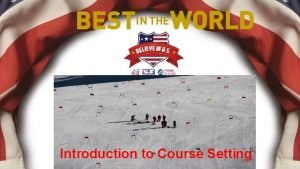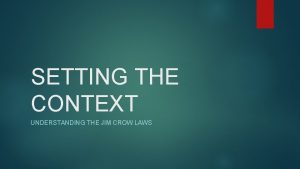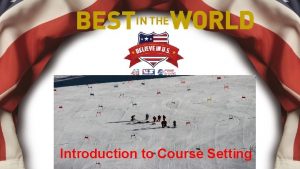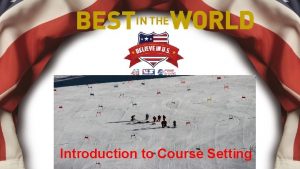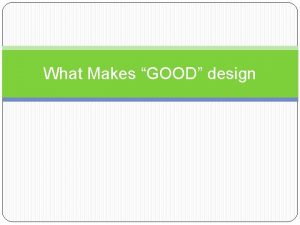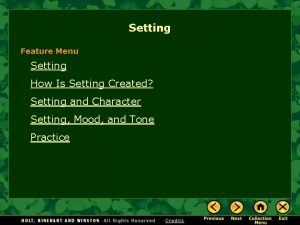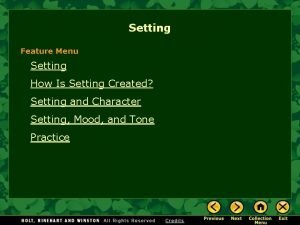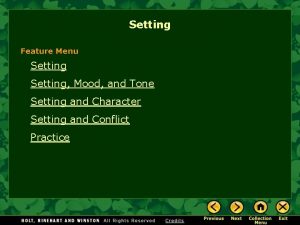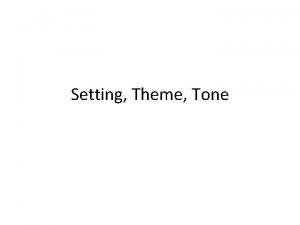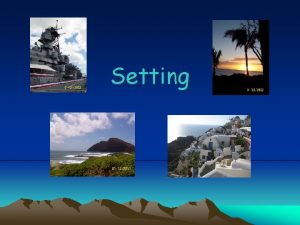Introduction to Course Setting What makes a good

















































- Slides: 49

Introduction to Course Setting

What makes a good course?

Key Setting Principles • Focus on safety • Set within the rules! • Set with rhythm and flow • Set to athlete’s abilities

Key Setting Principles • Finish gates should lead to middle of finish • Start and finish with even rhythm • Look up and down hill when setting • Set what you know, not what you think

Key Setting Principles Set With A PLAN! • Goal: Bring newly learned technical skill into gates • Goal: Prepare for a race on a hill with multiple fall-lines, your training hill is moderate with a single fall-line

What are some more course setting goals?

Setting By Discipline – USSA Alpine Officials Manual Ch 7, p. 7 -8 Race courses should be set appropriate to the level of competition and are required to be set within USSA and FIS specifications regarding the # of gates, width between poles, distance between successive gates, and restrictions applied to vertical combinations.

Race courses should have some rhythm and the preferred line should be obvious. The challenge should not be in memorizing the race course but in selecting the best line in the set.

Course setters should not rely merely on complex combinations of poles, as a selection of a general line that will test a variety of normal racing skills is the first objective. Race courses should be technically challenging and the gates should require competitors to make complete turns.

A race course should have a variety of turns, with varying radii in and out of the fall line and skillful use of the terrain, especially for GS.

The final gates of a race course should lead the competitor through the center of the finish gate, and course setters should anticipate setting into the finish several gates before the end of the race course. The course setter should check to see that poles are set in firmly to the proper height.

Children’s Course Setting Rules Train to Race Ratio (strongly recommended minimum) GS/SL Race Days 3 (recommended) Downhill (DH) U 1253 U 10 U 12 U 14 U 16 6: 1 (days) 5: 1 (days) Max. 10 Division/State organized, all events Max. 12 Division/State organized, all events Max. 14 Division/State organized, all events X X 50 m max. 350 m max 8% of vertical drop Max. 18 Division/State organized, all events As required 450 m max As required Combination 4 -6 m, Open 6 -10 m, Delay max. 15 m Combination 4 -6 m, Open 6 -12 m, Delay max 18 m Max. 140 m Max. 160 m Distance between gates 1 Vertical drop Direction changes Distance between gates 1 Slalom (SL) U 1254 Giant Slalom (GS) U 1255 Vertical drop Max. 100 m Max. 120 m Additional requirements Max. 3 hairpins, max. 1 vertical combination, max. 1 delay gate 2 -3 hairpins, 1 vertical combination Max. 1 delay gate Distance between gates 1 Open 15 -22 m, Delay max. 30 m Open 15 -25 m, Delay max. 35 m Max. 200 m Min. of 1 delay Variety of terrain suggested Max. 250 m Min. of 1 delay Variety of terrain suggested 22 -35 m Max. 300 m Min. 12% of vertical drop Max. 300 m Min. of 1 delay Variety of terrain suggested 25 -40 m Max. 350 m 8 -12% of vertical drop 2 Min. of 1 jump Training run required (U 1256. 4) All of above plus Skills. Quest events 1 pair - Multi-event Variety of terrain suggested 15 -20 m 100 m SL 6 -10 m, GS 12 -20 m 180 m (SL skis) GS 12 -20 m, SG 18 -28 m 250 m (GS skis) All of above plus Skills. Quest events 2 pair - SL, GS Variety of terrain suggested 15 -20 m 100 m SL 6 -10 m, GS 12 -20 m 200 m (SL skis) GS 12 -20 m, SG 18 -28 m 250 m (GS skis) All of above plus Skills. Quest events 3 pair - SL, GS, SG Length - skill/size appropriate Vertical drop Additional requirements Super G (SG) U 1256 Distance between gates 1 Vertical drop Direction changes Additional requirements Kombi - GS/SG U 1259 Distance between gates 1 Maximum vertical drop Other Events Ski Recommendation - Maximum (strongly recommended) Parallel Kombi - SL/GS U 1259 Combination 4 -5 m, Open 5 -9 m, Delay Combination 4 -6 m, Open 6 -10 m, Delay max. 15 m, distance to delay gate min. 4 m max. 15 m X 10 -15 m 60 m SL 6 -10 m, GS 12 -20 m 150 m X 3 -5 hairpins, 1 -2 vertical combinations and at least 1 delay gate Open 15 -27 m, Delay max. 35 m Max. 350 m Min. of 1 delay Variety in terrain is suggested 25 -45 m Max. 450 m 8 -12% of vertical drop Min. of 1 jump Training run recommended (U 1003. 2. 1) Variety of terrain suggested 15 -20 m 100 m SL 6 -10 m, GS 12 -20 m 200 m (SL skis) GS 12 -20 m, SG 18 -28 m 250 m (GS skis) All of the above plus combined and Skills. Quest events SL, GS, SG, DH

Slalom USSA ACR 802. 1. 2 -802. 1. 3 “The ideal SL course must include a series of turns designed to allow the competitors to combine speed with neat execution and precision of turns. The SL should permit the rapid completion of all turns. The course should not require acrobatics incompatible with normal ski technique…”

Slalom USSA ACR 802. 1. 2 -802. 1. 3 “It should be a technically clever composition of figures suited to the terrain, linked by single and multiple gates, allowing a fluent run, but testing the widest variety of ski technique, including changes of direction with very different radii. Gates should never be set only down the fall line, but so that some full turns are required, interspersed with traverses. ”

START First gate has outside pole Single Pole Slalom Single pole

Single pole Single Pole Slalom Single pole Last gate has outside pole FINISH

Single pole Delay has an outside pole Single pole

Single pole Hairpin has two poles Single pole

Single pole Flush Single pole

Single Pole Slalom

Slalom Distances • Vertical combinations – 4 -6 meters • U 10 4 -5 m – 0. 75 m-1 m between gates • Delays – 6 meters to delay gate • U 10 4 m – 12 -18 meters from turning pole to turning pole • U 14/U 12/U 10 max 15 m

Slalom Distances • Open gates – 13 m max for FIS and U 18 & older USSA – Gate count (turns) 30 -35% of vertical drop – Normal distances 9 -11 m • Children’s rules – open gates – U 10: 5 -9 m – U 12/U 14: 6 -10 m – U 16: 6 -12 m

Additional Requirements • Children’s rules – U 10: Up to 3 hairpins, up to 1 flush, up to 1 delay – U 12: 2 -3 hairpins, 1 flush, up to 1 delay – U 14/U 16: 3 -5 hairpins, 1 -2 flushes, at least 1 delay • USSA scored/FIS – At least 3 hairpins, 1 -3 flushes, 1 -3 delays

Slalom gates • Brushes • Stubbies • Youth gates – 25 mm or 27 mm diameter – 54” or 60” shaft length • Full-size gates – USSA 27 mm diameter, 69” shaft length – FIS 30 or 31 mm diameter, 69” shaft length

Giant Slalom USSA ACR 902 -903 “The terrain should preferably be undulating and hilly. The skillful use of the ground when setting GS is more important than for a SL, since combinations play a less important role owing to the prescribed width of the gates and the greater distances between them. It is therefore better to set mainly single gates, while exploiting the ground to the utmost. ”

Giant Slalom USSA ACR 902 -903 “A GS consists of a variety of long, medium and small turns. The competitor should be free to choose his own line between the gates. The full width of a hill should be used wherever possible. ”

Single Pole GS

Slalom • • Single pole SL Delays Flushes Trends – World Cup – J 3/J 4 suggestions • Distance, rhythm, length – Stubbies, brushes, J 4/J 5 gates

Delay

• • Giant Slalom Distances USSA scored/FIS – Minimum 10 meters, no max – Total number of gates (turns) 11 -15% of vertical drop Children’s rules – U 10/U 12: 15 -22 m (open) – U 14: 15 -25 m (open) – U 16: 15 -27 m (open) – U 10/U 12: Delay max of 30 m – U 14/U 16: Delay max of 35 m – Minimum of one delay

Kombi USSA ACR U 1259 “The children’s Kombi consists of a mixture of standard turns and gates. The event meets developmental needs for children, creating a tactical awareness by blending sections of different gates in a flowing, rhythmical, constantly changing pattern…The course should test the skier’s ability to react and adapt to an ever changing rhythm and radius, but allow the competitors smooth transition between the various sections of gates. ”

Kombi Rules • Include a minimum of one jump • Use the entire slope and natural terrain, skiing across the fall line as often as possible • Gates may consist of one or two poles • Recommended to have 3 -5 different sections • One section should consist of stubby gates

Kombi Distances • SL/GS Kombi – U 10 -U 16 – SL 6 -10 m – GS 12 -20 m – SL skis should be used • GS/SG Kombi – U 12 -U 16 – GS 12 -20 m – SG 18 -28 m – GS skis should be used

Super G USSA ACR 1003 “It is recommended to set the gates to make the best use of the terrain. A SG should contain a variety of long and medium turns. The competitor should be absolutely free to choose his own line between the gates. It is not permitted to set only down the fall-line of the slope. Where the terrain allows it jumps may be set. ”

Super G • • • Seek more learning, opportunities Start gradual – progression Familiarity of hill Importance of flow Set to security installations in place Factor the physical and psychological characteristics of the athletes

Corridor

Super G Rules • USSA scored/FIS – Minimum 25 m between turning poles (no max) – Minimum 15 m between gates in corridor – Minimum number of direction changes: 7% of vertical drop • USSA Children’s rules – U 12: 22 -35 m between turns, min 12% of VD – U 14: 25 -40 m between turns, 8 -12% of VD* – U 16: 25 -45 m between turns, 8 -12% of VD – U 14/U 16: Should have a jump

Downhill USSA ACR 702 -703 “A DH is characterized by the five components of technique, courage, speed, risk, and conditioning…Before difficult jumps and difficult passages the speed should be controlled by appropriate course setting where possible. ”

Mix it up! • Adjustment tools for the course setter: – Vary offset – Vary vertical distance – Set a delay – Set a combination • Possible challenges: – Thin snow/rock in line – Rotten snow – Accidentally set 2 gates in a row of the same color

Environmental factors • Terrain – Use it, if you don’t have it, simulate it – For less experienced skiers, terrain should be in transition between turns – Control speed before a breakover rather than after – Caution – turns in compression

Environmental factors • Course length – Gate count issues flat venue vs. steep venue – Alpine Training System – factors by age – Long hill vs short hill • Snow conditions – Soft snow – Ice – Cross ruts – Accumulating snow in the venue

Environmental factors • Weather/visibility – Foggy, heavy precipitation – Sun to shade considerations • Safety & obstacles – Safety available dictates your set – your set plan doesn’t trump safety and time factors – End courses high enough for plenty of finish room – Setting around lift towers, tree islands, etc.

Safety systems • • • Where are the fall zones? Purpose for fencing Setting B-net in a system Space Maintenance

Additional considerations • • Different gate options Setting outside of range for a training purpose Duals/Parallel Course setting and the race jury – In order to set at a USSA race, you must be a current USSA coach member and a current certified referee

Competition Setting Plan • • Junior Championship qualifier Open council race First race of the year Championship race

Review • How many gates are in a flush? • What is the maximum distance between open SL gates? • How far apart are gates in a hairpin? • What is the minimum distance between a delay gate and the turning pole above it in SL? In GS? In SG? • What is the maximum distance between gates in GS? • How is a Kombi set?

Review • How might you adjust your course set for very soft snow? • What is your most important consideration when setting a course? • What are the different gates you can use? • What member of the race jury can change the course set?

Level 200

Questions?
 Zoroastrianism beliefs
Zoroastrianism beliefs Good evening morning
Good evening morning Good afternoon students
Good afternoon students You are good when theres nothing good in me
You are good when theres nothing good in me Hello good afternoon teacher
Hello good afternoon teacher What makes a good story
What makes a good story What makes a good theory
What makes a good theory What makes a good questionnaire
What makes a good questionnaire What makes a good theory
What makes a good theory Qualities of good student
Qualities of good student Counterclaim persuasive writing
Counterclaim persuasive writing What makes a good story
What makes a good story What is the falling action in the story of cinderella
What is the falling action in the story of cinderella Electrophilic carbonyl
Electrophilic carbonyl What makes a good presentation
What makes a good presentation What makes a good model
What makes a good model Map with todals
Map with todals What makes a good friend
What makes a good friend What makes a good employee
What makes a good employee Affirming the consequent
Affirming the consequent What makes a good presentation
What makes a good presentation Example of testable question
Example of testable question What makes a good poster
What makes a good poster What makes a good lesson
What makes a good lesson What makes a good essay
What makes a good essay What makes a good poster
What makes a good poster What makes a good leader
What makes a good leader What makes a logo
What makes a logo Is ap seminar difficult
Is ap seminar difficult Target audience of radio
Target audience of radio What makes a good paragraph
What makes a good paragraph What do you think makes a good friend
What do you think makes a good friend Body of a letter
Body of a letter Zentangle self portrait
Zentangle self portrait What makes theatre good
What makes theatre good What makes a good negotiator
What makes a good negotiator Asadid
Asadid What is half brick wall
What is half brick wall Course number and title
Course number and title Chaine parallèle muscle
Chaine parallèle muscle Slalom hairpin flush
Slalom hairpin flush Understanding jim crow (setting the setting)
Understanding jim crow (setting the setting) Introduction to banking course
Introduction to banking course Imbe introduction course v2
Imbe introduction course v2 Introduction to software engineering course outline
Introduction to software engineering course outline Pied piping
Pied piping Simplex sentence
Simplex sentence Ron had a course introduction
Ron had a course introduction Good morning ladies song
Good morning ladies song Excellent very good good fair poor scale
Excellent very good good fair poor scale







